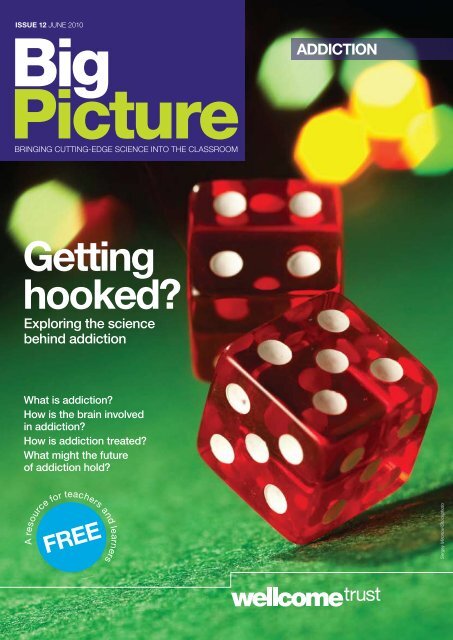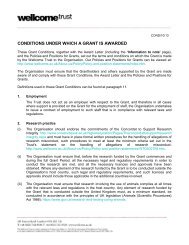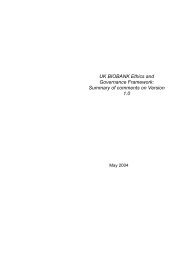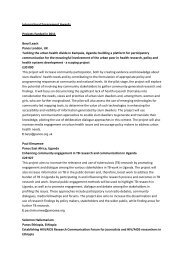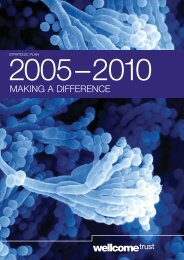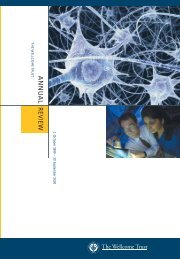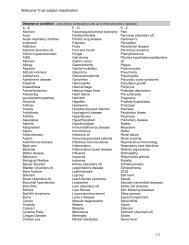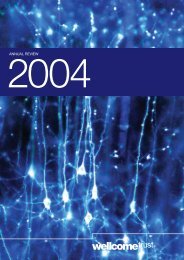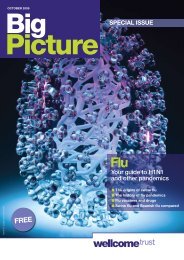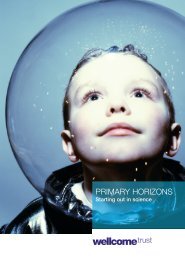Big Picture: Addiction - Wellcome Trust
Big Picture: Addiction - Wellcome Trust
Big Picture: Addiction - Wellcome Trust
You also want an ePaper? Increase the reach of your titles
YUMPU automatically turns print PDFs into web optimized ePapers that Google loves.
ISSUE 12 june 2010<br />
<strong>Big</strong><br />
<strong>Picture</strong><br />
ADDICTION<br />
bringing CUTTING-EDGE SCIENCE INto THE CLASSROOM<br />
Getting<br />
hooked<br />
Exploring the science<br />
behind addiction<br />
What is addiction<br />
How is the brain involved<br />
in addiction<br />
How is addiction treated<br />
What might the future<br />
of addiction hold<br />
FREE<br />
A resource for teachers and learners<br />
Sergey Mironov/iStockphoto
<strong>Big</strong><br />
<strong>Picture</strong><br />
<strong>Big</strong> <strong>Picture</strong><br />
<strong>Big</strong> <strong>Picture</strong> is a free resource for teachers,<br />
school and college students, and learners<br />
of any age. Published twice a year, each<br />
issue comes as a printed magazine with<br />
accompanying online articles and other<br />
content. Here’s how to get the most from<br />
your issue.<br />
Contents<br />
Introducing addiction<br />
Explore the history of drink, drugs and addiction.<br />
What is addiction<br />
What things can be addictive Who gets addicted<br />
The brain and addiction<br />
How is the brain involved in and altered by addiction<br />
Case studies: internet use and gambling<br />
Can surfing the web or gambling be addictive<br />
Dealing with addiction<br />
What kinds of treatment are available for addicts<br />
The future of addiction<br />
What are the ethical issues of our imagined scenarios<br />
Real voices<br />
Hear from three people with experiences of addiction.<br />
3<br />
4–5<br />
6–7<br />
8–9<br />
10–11<br />
12–13<br />
14–15<br />
How to use <strong>Big</strong> <strong>Picture</strong> magazine<br />
How to use the <strong>Big</strong> <strong>Picture</strong> website<br />
Each issue of <strong>Big</strong> <strong>Picture</strong> focuses on a topic that is current,<br />
relevant to the biology curriculum, rooted in science, and that has<br />
debate-provoking aspects. The issues are divided into doublepage<br />
spreads, each dealing with a different aspect of the topic.<br />
The spreads are a jigsaw of articles, images, diagrams and ‘Fast<br />
Facts’, allowing you to dip into each issue, and each spread, as<br />
you need. Every issue contains a series of ‘real voices’ – interviews<br />
with people whose lives are affected and shaped by the topic in<br />
question. Whether you want to stimulate debate, to provide up-todate,<br />
scientifically accurate examples around particular issues, or<br />
to get across complex ideas to your students, <strong>Big</strong> <strong>Picture</strong> helps<br />
you to bring cutting-edge science into your classroom.<br />
As well as twice-yearly magazines, there’s loads of other useful<br />
material on the <strong>Big</strong> <strong>Picture</strong> website<br />
(www.wellcome.ac.uk/bigpicture). The exclusive online<br />
content is created for each issue, and includes articles, videos,<br />
games, image galleries, animations, lesson plans, activities and<br />
more. Our selected links help you and your students to get the<br />
most out of the web for each topic.<br />
Also on this site, you can download PDFs of the current and all<br />
12 past issues of <strong>Big</strong> <strong>Picture</strong>. There are also curriculum-matching<br />
details, and info on how to order copies of the magazines.<br />
1<br />
2<br />
1<br />
4 4<br />
2<br />
3<br />
3<br />
1<br />
2<br />
3<br />
4<br />
Title – Each spread deals with a particular aspect of the<br />
title topic.<br />
Intro – This sets the scene for the spread within the issue,<br />
and the wider world.<br />
Article – Each article can be used alongside others from the<br />
same spread or the rest of the issue, or as a standalone<br />
component for a lesson.<br />
Image/diagram – Illustrations and diagrams help you express<br />
complex ideas in a visual way, as well as helping to place the<br />
issues in question into a real-life context.<br />
1<br />
2<br />
3<br />
4<br />
Left-hand menu – Browse <strong>Big</strong> <strong>Picture</strong> online by title,<br />
article, activity or resource.<br />
Current issue heading – Explore the online content for<br />
the latest issue.<br />
Recent issues heading – Explore the online content<br />
for past issues.<br />
Sign-up link – Sign up to receive issues of <strong>Big</strong> <strong>Picture</strong><br />
and other <strong>Wellcome</strong> <strong>Trust</strong> publications.<br />
2 • <strong>Big</strong> <strong>Picture</strong> 12: ADDICTION
Introducing addiction<br />
<strong>Addiction</strong> is a term we all use,<br />
but what do we mean<br />
Do something pleasurable, and the chances<br />
are that you want to do it again. Do it a lot –<br />
whether it is eating a chocolate bar or watching<br />
a band on YouTube – and you have a habit.<br />
Most habits are pretty harmless. The worst<br />
thing likely to happen is that you waste time<br />
on them or people make fun of them. A few,<br />
though, turn into a problem. Sometimes that<br />
problem is so serious we call it an addiction.<br />
The addictions with the tightest grip tend<br />
to involve drugs, sometimes illegal ones. But<br />
take a look in the papers: people who can’t get<br />
enough of sunbeds, shopping or sex are all<br />
addicts, journalists say. Are they really What<br />
about those unable to control how much they<br />
gamble or surf the web Deciding whether<br />
these really are addictions means having a<br />
clear definition of what addiction is. That is<br />
difficult, because addicts do not just feel one<br />
thing. Most definitions amount to a list of<br />
features, and people then discuss whether a<br />
particular behaviour can count as an addiction.<br />
All the definitions agree that addiction<br />
involves psychological need: you really<br />
feel you cannot do without it. Then there is<br />
physical need: cutting off supply makes you ill.<br />
Tolerance is common: where you need more<br />
and more of the thing you are addicted to for<br />
the same effect. So is persistence: the fact that<br />
you’ll continue with a particular behaviour in<br />
spite of its harmful effects.<br />
Some addictions, especially to certain drugs,<br />
tick all of these boxes. Other things that may<br />
be addictive, such as gambling, do not. In<br />
those cases, there is more of an overlap<br />
with obsessive or compulsive behaviour of<br />
other kinds.<br />
So addiction is complex, involving<br />
aspects of brain and body that are not well<br />
understood, along with social influences and<br />
personal history. That leaves plenty of room for<br />
disagreement among researchers and health<br />
workers about its diagnosis, causes, effects,<br />
treatment and prevention.<br />
Old habits<br />
A history of drink,<br />
drugs and addiction.<br />
7000 BCE<br />
Oldest known alcoholic<br />
drink, identified from<br />
traces left on pottery<br />
excavated from a<br />
site in China. Some<br />
archaeologists believe<br />
cultivating fermentable<br />
crops was a key<br />
factor in the origins<br />
of agriculture, and<br />
so is as old as<br />
human settlement.<br />
1875<br />
San Francisco city<br />
ordinance bans<br />
use of opium,<br />
the earliest US<br />
prohibition.<br />
1860<br />
First pure cocaine<br />
extracted from<br />
coca leaves. Coca<br />
extracts in wide<br />
use in tonics and<br />
patent medicines<br />
in Europe and<br />
the USA.<br />
4000 BCE<br />
Opium poppies<br />
domesticated<br />
in the western<br />
Mediterranean.<br />
Opium,<br />
which can<br />
be harvested<br />
from the wild,<br />
is probably the<br />
oldest narcotic.<br />
1839<br />
The British force China to<br />
allow continued importation<br />
of opium, mainly from their<br />
territories in India. This<br />
helps finance the new trend<br />
among the English at home,<br />
tea-drinking.<br />
1890<br />
Popular fictional<br />
detective Sherlock<br />
Holmes is described<br />
in The Sign of Four<br />
injecting cocaine.<br />
Holmes, also a<br />
user of morphine,<br />
describes cocaine to<br />
an anxious Dr Watson<br />
as “transcendently<br />
stimulating and<br />
clarifying to the mind”.<br />
1956<br />
American Medical<br />
Association declares<br />
alcoholism a disease.<br />
4000 BCE<br />
Cannabis in use<br />
as a narcotic<br />
in Eurasia.<br />
1200 CE<br />
The Incas in South<br />
America adopt the<br />
traditional Andean<br />
habit of chewing<br />
coca leaves (which<br />
contain cocaine),<br />
and declare coca<br />
a sacred plant.<br />
1729<br />
Faced with a gin<br />
craze, especially<br />
among the poor<br />
in London,<br />
Parliament passes<br />
the first of a series<br />
of laws trying to<br />
control gin drinking.<br />
1599<br />
Shakespeare uses the word “addiction” in<br />
Henry V. At that time, it meant to be bound<br />
to someone as a slave, or by excessive<br />
devotion, hence “His addiction was to<br />
causes vain…”<br />
1997<br />
Alan Leshner, Director of<br />
US National Institute<br />
on Drug Abuse, publishes<br />
review paper in Science<br />
concluding that “addiction<br />
is a brain disease”.<br />
1614<br />
First shipment of<br />
Virginia tobacco<br />
auctioned in<br />
London. It breaks<br />
a Spanish<br />
monopoly on the<br />
weed, and creates<br />
a demand for<br />
labour that is to be<br />
met by the<br />
slave trade.<br />
2008<br />
Premiere of US series<br />
Celebrity Rehab with<br />
Dr Drew. In this reality<br />
show celebrities<br />
undergo 21 days’<br />
treatment for drug<br />
or alcohol addiction,<br />
and are filmed 24/7.<br />
JUNE 2010 • 3
<strong>Picture</strong><br />
<strong>Big</strong><br />
What is addiction<br />
Ask ten people what they think addiction is, and you’ll have ten different<br />
answers. Even key health bodies can’t agree. What most people do accept,<br />
though, is that the basis of addiction is very complex: a combination of<br />
biological, genetic, psychological and social factors. We all have pleasurable<br />
experiences, but we don’t all become addicted to everything. So what<br />
makes something addictive And what makes someone become addicted<br />
Defining addiction<br />
How do key health bodies define addiction<br />
World Health Organization<br />
The World Health Organization (WHO), the UN-backed body<br />
based in Geneva, prefers to talk about ‘dependence’ rather than<br />
addiction. For drugs, it uses this word to cover both addiction and habituation<br />
(drug-taking becoming a habit psychologically). Back in 1964, a WHO expert<br />
committee offered a definition of dependence that brought in aspects of<br />
behaviour, cognition and physiology. The latest WHO International Classification<br />
of Diseases says that dependence includes strong desire, problems controlling<br />
use, withdrawal symptoms, tolerance for increasing doses, ignoring alternatives,<br />
and continuing to use a drug in spite of the harm it causes.<br />
American Psychiatric Association<br />
Dependence and addiction are seen differently by the American Psychiatric<br />
Association (APA), which is revising its official manual of mental disorders (above).<br />
In the latest draft, the ‘substance-related disorders’ category has been expanded<br />
to include, for the first time, a non-substance addiction: gambling. The APA<br />
will consider others, including internet addiction, when more research has been<br />
carried out.<br />
The revision group is proposing to use ‘addiction and related disorders’<br />
as a new name for the ‘substance-related disorders’ category. It thinks that<br />
‘dependence’ should be used only to describe a precise physiological response<br />
to particular substances, saying that using it to describe out-of-control drug use<br />
has been confusing for doctors.<br />
Life’s a drag<br />
What makes smoking so<br />
attractive to so many<br />
Smoking cigarettes is the most widespread<br />
addiction worldwide because it delivers a<br />
powerful chemical, nicotine, very effectively. Take<br />
a puff and the nicotine level in the brain peaks<br />
around ten seconds later. The effect wears off<br />
quickly, so the smoker quickly has another go.<br />
For many people, it is not long before the habit is<br />
hard to break. This, added to the ritual of lighting<br />
up (often in company), the unpleasant effects<br />
of nicotine withdrawal, and – although there are<br />
now tight controls in the UK – a history of heavy<br />
advertising of tobacco products, gives you a<br />
foolproof recipe for mass addiction.<br />
But not everyone tries it. And not everyone who<br />
tries it keeps on smoking. You have to learn how<br />
to do it – the smoke can be off-putting at first.<br />
And plenty of other factors, such as the price of a<br />
packet of cigarettes, and whether friends think it<br />
is cool, help decide whether anyone becomes a<br />
wheezing 60-a-day smoker, a lifelong abstainer or<br />
something in between.<br />
What is addictive behaviour<br />
For many, the<br />
concept of addiction<br />
has typically involved<br />
drugs. In the 1990s,<br />
two researchers<br />
proposed wider<br />
models that included<br />
other behaviours.<br />
Which do you think is<br />
most comprehensive<br />
Do you see any overlap<br />
between the two What<br />
would you add to or<br />
take away from these,<br />
bearing in mind other<br />
definitions of addictions<br />
you have come across<br />
Glenn Walters<br />
“the persistent and<br />
repetitious enactment<br />
of a behaviour pattern”<br />
The 4 ‘P’s<br />
Progression<br />
to higher tolerance<br />
and risk of withdrawal<br />
symptoms<br />
Preoccupation<br />
with the behaviour<br />
Perceived<br />
loss of control<br />
Persistence<br />
in spite of negative consequences<br />
Potentially addictive<br />
behaviour<br />
Vulnerable individuals<br />
Addictive<br />
behaviour<br />
Mark Griffiths<br />
“need to be fulfilled if a behaviour<br />
is to be defined as ‘addictive’”<br />
Salience<br />
The activity is the most important thing in your life<br />
Mood modification<br />
You feel a ‘buzz’ or a ‘numbing’ from the activity<br />
Tolerance<br />
A need to increase the amounts of the activity<br />
to get the same feeling as before<br />
Withdrawal symptoms<br />
Unpleasant feelings and/or physical effects<br />
when activity reduced or stopped<br />
Conflict<br />
Within you or between you and those around you<br />
Relapse<br />
Tendency to go back repeatedly to a particular<br />
activity, even after a long period without it<br />
The <strong>Addiction</strong> Concept.<br />
Needham Heights,<br />
MA: Allyn and Bacon; 1999.<br />
Nicotine, tobacco and addiction.<br />
Nature 1996;384(6672):122.<br />
4 • <strong>Big</strong> <strong>Picture</strong> 12: ADDICTION
Graph: Adapted from Nutt et al.<br />
Lancet 2007;369(9566):1047–53.<br />
Mean harm score (from independent experts)<br />
3.0<br />
2.5<br />
2.0<br />
1.5<br />
1.0<br />
0.5<br />
0.0<br />
Heroin<br />
UK researchers assessed the harmfulness of 20 substances<br />
How does harm relate to legal classification<br />
Classification under the<br />
Misuse of Drugs Act<br />
A<br />
B<br />
C<br />
No class<br />
Cocaine<br />
Barbiturates<br />
Street methadone<br />
Alcohol<br />
Ketamine<br />
Benzodiazepines<br />
Amphetamine<br />
Tobacco<br />
Buprenorphine<br />
Cannabis<br />
Solvents<br />
4-MTA<br />
LSD<br />
Methylphenidate<br />
Anabolic steroids<br />
GHB<br />
Ecstasy<br />
Alkyl nitrates<br />
Khat<br />
Substance<br />
Just like a drug<br />
Some things are more addictive than others.<br />
Drugs top the bill of addictive substances. Efforts to rank<br />
them generally take into account the good feelings – or<br />
intoxication – from taking a drug, whether users develop<br />
tolerance to its effects, how bad withdrawal symptoms<br />
can be, and how hard it is to stay off if you stop. With all<br />
these things in mind, heroin is generally considered<br />
more addictive than cocaine, but less so than nicotine<br />
– and crack cocaine even more so than cocaine alone.<br />
Alcohol, coffee and marijuana (cannabis) come lower<br />
down the list.<br />
Other drugs are not physically addictive. Ecstasy<br />
(MDMA), for instance, does not lead to the uncontrollable<br />
craving (intense desire) for more seen with some other<br />
drugs. In fact, repeated use of MDMA seems to go along<br />
with reduction in the amount of the neurotransmitter<br />
serotonin in the brain, which may limit some of MDMA’s<br />
pleasurable effects.<br />
Addicted to mobiles<br />
Is everything potentially<br />
addictive<br />
<strong>Addiction</strong> isn’t just associated with drugs.<br />
If you have a mobile phone, do the<br />
bills shock you Do people in your family<br />
complain that you use it too much Does<br />
keeping up with friends on the phone get<br />
in the way of other things, such as<br />
school Is your use still creeping up Do<br />
you keep upgrading to a sexier model<br />
Who’s vulnerable<br />
A person’s experiences, genes<br />
and environment are all factors.<br />
A person’s chances of developing<br />
an addiction depend on what they<br />
are like, and what happens to them.<br />
Where you live matters a lot, too –<br />
for example, is gambling widespread<br />
there Are drugs available<br />
Early exposure to stress or trauma,<br />
especially child abuse, is strongly<br />
linked with later drug use. Parental<br />
drug addiction is also a big risk as it<br />
can combine a disrupted childhood,<br />
genetic risk factors and access to<br />
drugs. Less dramatically, teenagers<br />
may be influenced by their friends,<br />
and be drawn to places where drug<br />
use is seen as ‘normal’.<br />
There are also strong and<br />
complex links between addiction<br />
and mental illness. People with<br />
bipolar disorder are more than<br />
three times as likely to be smokers<br />
as those with no mental illness, for<br />
Do you get really upset if you cannot get<br />
a signal for more than a few minutes If<br />
so, says, Mariano Choliz of the University<br />
of Valencia in Spain, your relationship<br />
with your mobile has the marks of an<br />
addiction.<br />
The point is that these are similar to<br />
the tests being applied by experts trying<br />
to decide whether to include gambling<br />
and uncontrollable internet use in official<br />
manuals of diseases. If these can be<br />
diagnosed as addictions, could any<br />
compulsive behaviour be<br />
The route to this kind of behavioural<br />
fixation is different from the path to<br />
substance dependence – as any effects<br />
on the brain are indirect. Calling them<br />
addictions is controversial. Some argue<br />
such compulsions usually stem from<br />
some other underlying cause, such as<br />
depression or anxiety.<br />
Libby Welch<br />
example. But do mental disorders<br />
put people at risk for addiction, or the<br />
other way round Both might be true.<br />
Or maybe other predisposing factors<br />
– such as child abuse, or genetic<br />
variations – leave some people more<br />
vulnerable to both mood or anxiety<br />
disorders and addictions of various<br />
kinds. What is certain is that there<br />
is a high incidence of ‘comorbidity’,<br />
where the same person has both,<br />
and each affects the other.<br />
Some American soldiers in Vietnam in the early 1970s<br />
smoked heroin, encouraged by easy access, the<br />
stresses of service in a strange land or by boredom.<br />
When they came back home, two-thirds of them<br />
lost the habit within a year<br />
or two. Those who had<br />
seen combat, and often been<br />
traumatised, were more<br />
likely to remain addicts when<br />
back in the USA. Others<br />
abandoned heroin but took<br />
up barbiturates or<br />
amphetamines instead.<br />
Runs in the family<br />
What role do your genes play in<br />
predisposing you to becoming addicted<br />
Sometimes the chances of addiction are strongly<br />
influenced by a person’s genetic make-up. The mostused<br />
method of studying this is to compare the lives of<br />
pairs of identical twins (who share the same variations<br />
in DNA sequence) and non-identical pairs. Traits that<br />
show a closer resemblance in the identical pairs are<br />
typically under stronger genetic influence.<br />
On this basis, there are genetic factors involved<br />
in susceptibility to alcoholism, and in the use of<br />
other drugs such as cocaine, heroin and nicotine. We<br />
can inherit different versions of certain genes that<br />
produce variation in the ways particular substances<br />
such as nicotine are processed (metabolised) in<br />
cells. They can alter levels of one of the chemicals<br />
that act as neurotransmitters, helping brain cells<br />
to signal to each other. Finally, there are genes that<br />
influence general aspects of behaviour, such<br />
as desire for new experiences, or risk-taking.<br />
The inherited influences on anyone’s<br />
vulnerability to addiction are normally a result<br />
of complex combinations of such genes,<br />
working out in ways that are affected by their<br />
life and environment. Some may be more<br />
susceptible to particular substances because of<br />
their biochemistry. Others may show broader<br />
behaviour patterns, such as impulsiveness,<br />
which sometimes lead to addiction. This may<br />
mean there is something in the idea often<br />
discussed by psychologists that there is an ‘addictive<br />
personality’, although the existence of well-defined<br />
trait that justifies that term remains controversial.<br />
Rowan McOnegal<br />
Craig DeBourbon/iStockphoto<br />
VisualCommunications/iStockphoto<br />
JUNE 2010 • 5
<strong>Big</strong><br />
<strong>Picture</strong><br />
Digital Vision<br />
Photography/Veer<br />
The brain and<br />
the addiction<br />
Developments in neuroscience, and in brain<br />
imaging in particular, mean that our understanding<br />
of the brain’s role in addiction is always growing.<br />
However, there is still a lot we don’t know. For<br />
example, while researchers are revealing the brain<br />
regions and processes linked to addiction, it is<br />
unclear how this activity is related to a person’s<br />
behaviour and life choices – also key in addiction.<br />
All in the mind<br />
A brief look at the psychological<br />
theories of addiction.<br />
Addicts have a problem with decisions. Even<br />
if, in theory, there is always a choice of what to<br />
do next, the addict keeps on doing the same<br />
thing. There are a range of psychological<br />
theories to explain this. Cognitive models look<br />
at what people know and how they process<br />
information. Behavioural models focus on<br />
how the mind reacts to information and other<br />
stimuli to generate set patterns of choice. The<br />
distinction is not completely clear-cut, though.<br />
Some treatment programmes are based on<br />
cognitive behavioural models, and focus on<br />
helping addicts to try to understand their<br />
patterns of thought and perception so they<br />
have a chance of altering their own behaviour.<br />
Essentially, they ‘unlearn’ the habits that add<br />
up to addiction. For more on treatment see<br />
pages 10 and 11.<br />
Like a rat in a cage<br />
How are animal studies used<br />
to study addiction<br />
A laboratory animal, most often a rat<br />
or mouse, can be hooked up so that<br />
it can give itself a dose of a drug. If it<br />
keeps on and on with fresh doses, the<br />
chances are that the drug is addictive.<br />
Sometimes, the animals ignore food<br />
and water in favour of another tiny hit<br />
of cocaine, for example.<br />
Building on this, researchers have<br />
learned a great deal about the brain<br />
circuits involved in addiction. The<br />
results show that drugs are usually<br />
blunt instruments that affect the<br />
delicate complexity of the brain in lots<br />
of different ways. For example, the<br />
4x6/iStockphoto<br />
brain sites at which drugs produce<br />
‘physical’ dependence – and<br />
withdrawal symptoms – are distinct<br />
from those involved in their habitforming<br />
effects. That second set are<br />
tied up with the circuits that<br />
regulate rewards.<br />
Different substances produce<br />
similar effects in different ways.<br />
Drugs that are addictive to humans,<br />
and that animals also seek out,<br />
nearly all enhance the natural reward<br />
mechanisms in the brain. They can<br />
either do this by increasing the rate at<br />
which neurons fire in particular brain<br />
regions, or by boosting production<br />
of the key neurotransmitter<br />
chemical, dopamine.<br />
Rats and mice lack some features<br />
of human behaviour and intelligence,<br />
but most parts of their brains are small<br />
versions of the human equivalents.<br />
Among the many experiments using<br />
laboratory animals are studies of<br />
treatment and relapse (returning<br />
to use of the substance) as well<br />
as initial addiction.<br />
Taking things to the extreme<br />
How people with Parkinson’s shed light<br />
on the effects of too much dopamine.<br />
One group of patients given a therapeutic drug have<br />
been part of an unintended experiment in addiction.<br />
People with Parkinson’s disease develop muscle tremors<br />
because of a lack of dopamine, and are given a dopamine<br />
precursor, L-dopa, or dopamine agonists (drugs that<br />
stimulate dopamine receptors in the brain in the<br />
absence of dopamine) to help to control their symptoms.<br />
A small percentage begin using more of these drugs<br />
than is needed to regain muscle control. They may<br />
also develop disordered behaviour, including compulsive<br />
gambling, shopping, eating or seeking sex. This condition<br />
is known as dopamine dysregulation syndrome. The precise<br />
relationship between cause and effect is not yet known,<br />
but it is yet another link between the dopamine system and<br />
addiction. Studying which people are more vulnerable to<br />
this iatrogenic condition (one induced by medical care) may<br />
help to unravel influences on other drug addictions. Some<br />
patients who became compulsive gamblers are suing the<br />
company that manufactures a particular dopamine agonist.<br />
Dopamine, a chemical involved in the brain’s reward system.<br />
My chemical romance<br />
Drugs exploit the brain’s reward<br />
system to have their effects.<br />
Evidence of the role of the brain’s reward circuitry in<br />
addiction is reinforced by the results of studies in<br />
which animals are wired up so that they can use an<br />
electric current to stimulate directly the parts of the<br />
brain involved. Again, they like it a lot, and will repeat<br />
the stimulation until exhaustion sets in.<br />
As with drugs, the underlying attraction is the boost<br />
in the activity of the reward system. The key result is<br />
an increase in the amount of dopamine in the nucleus<br />
accumbens, a small region in the forebrain with ancient<br />
evolutionary origins, which helps to regulate survival drives<br />
such as food and thirst. Biochemical and brain-imaging<br />
studies suggest this region is involved in registering many<br />
kinds of reward, including some from non-drug addictions,<br />
and in the memory of past rewards, which helps to<br />
maintain addiction.<br />
This idea also fits with genetic evidence. For instance,<br />
smokers who have one version of a gene for a dopamineregulating<br />
enzyme have problems concentrating when they<br />
are low on nicotine, and find it harder to give it up. And<br />
people classified psychologically as novelty seekers are<br />
likely to have fewer of one type of dopamine receptor.<br />
Dopamine is only part of the story, though. Several<br />
other neurotransmitters have been implicated in<br />
different aspects of drug action, reward and relapse after<br />
treatment. They include serotonin, which also acts in the<br />
nucleus accumbens, and the chemical that helps to tune<br />
the activity of many different types of neurons, GABA<br />
(gamma-aminobutyric acid).<br />
Laguna Design/SPL<br />
6 • <strong>Big</strong> <strong>Picture</strong> 12: ADDICTION
Libby Welch<br />
Looking in the brain<br />
Imaging techniques help researchers<br />
get into addicts’ heads.<br />
The brains of laboratory animals can be analysed to yield extremely<br />
precise data – down to the firing of single neurons – while they are<br />
taking in drugs. Looking at the reward system in human brains has<br />
to be less direct, but modern imaging wizardry shows things going<br />
on in there that fit with the animal findings.<br />
The most often-used technique is functional magnetic<br />
resonance imaging (fMRI). This technique shows changes in<br />
blood flow in small parts of the brain, with the implication being<br />
that areas with increased blood flow are more active. Such<br />
studies show, for instance, that the brain’s reward regions ‘light<br />
up’ under the influence of cocaine injections. Another technique,<br />
positron emission tomography (PET), can probe more specific<br />
aspects of brain biochemistry.<br />
Imaging studies also confirm that the brain regions that are<br />
activated when cocaine addicts are offered a hit, such as the<br />
nucleus accumbens, also react when addicts are shown drugrelated<br />
images such as white lines on a mirror. Other studies<br />
have shown similar results with compulsive gamblers looking at<br />
photos of slot machines.<br />
FAST FACT<br />
Some constituents of tobacco smoke, such as<br />
acetaldehyde, increase the rewarding properties<br />
of nicotine, which is why smoking is more<br />
rewarding than nicotine patches.<br />
Source: Belluzzi et al. Neuropsychopharmacology<br />
2005;30:705–12.<br />
Functional magnetic resonance imaging scans of cocaine addicts’ brains after they<br />
received cocaine injections. The injected cocaine activated brain regions associated<br />
with dopamine-based reward pathways, including the nucleus accumbens and<br />
prefrontal cortex. Red and yellow show regions that were significantly more responsive<br />
to cocaine than to a control (salt solution). Blue regions were less responsive to cocaine.<br />
The more extreme the colour on the scale, the more confidence in the result.<br />
3.3<br />
-3.3<br />
From Kufahl et al. Neuroimage<br />
2005;28(4):904–14.<br />
The brain’s<br />
reward system<br />
Prefrontal cortex – Part of<br />
the frontal lobe that is involved<br />
in many cognitive functions,<br />
including memory, language,<br />
planning and decision making.<br />
Nucleus accumbens –<br />
A small region in the forebrain<br />
with ancient evolutionary<br />
origins, which helps regulate<br />
survival drives like food<br />
and thirst.<br />
Affected by drugs including<br />
cocaine, amphetamine,<br />
cannabinoids (e.g cannabis)<br />
and opioids (e.g. heroin).<br />
Ventral tegmental area –<br />
Found in the midbrain, this<br />
area produces dopamine<br />
and forms part of one of four<br />
major dopamine pathways in<br />
the brain.<br />
Affected by drugs including<br />
nicotine, alcohol and<br />
opioids (e.g. heroin).<br />
Dopamine movement<br />
Brain changing<br />
What does addiction<br />
do to your brain<br />
Addicts’ brains show differences from people<br />
who have no addictions. They can include<br />
changes in gene expression, in connections<br />
within and between parts of the brain, and in<br />
levels of neurotransmitters and their receptors –<br />
especially the key reward chemical, dopamine.<br />
At a higher level, changes in perception and<br />
information processing also happen.<br />
These differences can be generated as<br />
addiction develops. Sometimes, they may have<br />
been there all along. So addiction does change<br />
the brain, but some people’s brains predispose<br />
them to get addicted in the first place.<br />
The brain–addiction link is reinforced by<br />
evidence that some kinds of brain damage can<br />
help to reduce addictions. The insula is a small<br />
part of the cerebral cortex involved in feeling<br />
and emotion. A high percentage of cigarette<br />
smokers who suffer brain damage from a<br />
stroke find it easy to give up if the damage<br />
involves the insula. They lose their craving for<br />
nicotine, although their appetite for food and<br />
drink remains normal. Experiments with rats<br />
whose brains are partially anaesthetised have<br />
shown a similar effect for amphetamine.<br />
More dramatic are reports that Russian and<br />
Chinese surgeons performed surgery to ‘cure’<br />
heroin addiction in hundreds of patients, using<br />
electrodes to destroy certain parts of the brain.<br />
Experts elsewhere say the published results<br />
of these procedures are incomplete. Other<br />
treatments are equally effective, they argue,<br />
and there are doubts about the safety of the<br />
procedures, and whether addicts consented<br />
to the operations. The Russian and Chinese<br />
governments have now banned this treatment.<br />
JUNE 2010 • 7
<strong>Big</strong><br />
<strong>Picture</strong><br />
Online, all the time<br />
Some people count compulsive use of the internet –<br />
usually for social networking or game playing – as<br />
an addiction. There is not yet much research on who is<br />
affected. Many studies in the news come from clinics<br />
promoting ‘treatment’ for the condition. However, what<br />
is known indicates, as usual, that some people are<br />
more at risk than others.<br />
Cognitive risk factors<br />
Young people spending much<br />
of their time online are more<br />
likely to report being unhappy.<br />
Research in Taiwan (several<br />
Asian countries including China<br />
report high levels of internet<br />
addiction) suggested that<br />
11-year-olds who showed signs<br />
of depression, attention deficit<br />
hyperactivity disorder, social<br />
phobia or hostility were more<br />
likely to develop an internet<br />
fixation when they became<br />
adolescents.<br />
Genetic risk factors<br />
There are no clear genetic<br />
factors, although the problem<br />
appears more common in<br />
males than females.<br />
The incidence of ‘internet addiction’ is<br />
unclear. In terms of ‘normal use’, it is<br />
reported that 99 per cent of UK children<br />
aged eight to 17 have access to the<br />
internet. Playing video games is one of the<br />
top online activities. Almost half of boys<br />
aged seven to ten play games online, but<br />
this proportion seems to fall with age.<br />
However, just over a third of boys aged<br />
11–16 have access to the internet via a<br />
games console. There is evidence of heavy<br />
use of some online games, especially<br />
multiplayer role-playing games, that take<br />
place in complex ‘virtual worlds’, e.g. World<br />
of Warcraft. Even average players devote<br />
22 hours a week to the game.<br />
A University of Leeds study in 2010<br />
suggested that 1.2 per cent of people<br />
were ‘internet addicts’, and many of those<br />
were depressed. However, critics noted<br />
that recruitment to this study was via social<br />
networking sites, so it did not register<br />
non-internet users. Others suggested that<br />
the results showed that the problem is<br />
depression, not internet use.<br />
Demographic risk factors<br />
Some studies suggest that a<br />
university-level education<br />
combined with a poor financial<br />
situation increases the risk.<br />
Why are online gaming<br />
and social networking<br />
addictive<br />
Games can be addictive, in<br />
the loose sense of the word,<br />
because of their constantly<br />
repeated challenges and<br />
rewards, often moving through<br />
skill levels that reinforce the<br />
player’s interest. The immersion<br />
in a fictional world may reduce<br />
interest in dealing with people in<br />
the ‘real’ world outside, though<br />
this may only affect people<br />
already seeking escape.<br />
What harm does it cause<br />
Compulsive internet use can lead to neglect<br />
of family, friends and other interests, sleep<br />
deprivation and problems with schoolwork.<br />
Those affected may be bored, anxious or<br />
irritable when they cannot get online. Then<br />
again, some people feel the same way when<br />
they cannot get to the gym or watch their<br />
favourite soap.<br />
Any similarities to substance dependency<br />
Some studies claim that internet use can resemble substance addiction for some people, who<br />
show a preoccupation with their compulsion: they are always replaying the last game session<br />
or thinking about the next one. There may also be signs of tolerance, inability to cut back on<br />
use and withdrawal symptoms, but no physical dependency.<br />
8 • <strong>Big</strong> <strong>Picture</strong> 12: ADDICTION
Double or quits<br />
Gambling is an ancient pastime that exists in new<br />
forms today. Some problem gamblers have<br />
difficulties controlling their gambling and run<br />
up crippling debts. Compulsive gambling<br />
has been studied more extensively than other<br />
non-drug addictions.<br />
Genetic risk factors<br />
A twin study in the USA published in 2010 suggested that<br />
genetic factors account for around 70 per cent of the variance in<br />
gambling. However, in line with some other studies, there were<br />
significant differences between men and women. For males there<br />
was 85 per cent genetic influence on gambling. For females, no<br />
genetic influence was measured – the differences between those<br />
in this group were all due to environmental factors.<br />
Statistics for gambling, including problem<br />
gambling, are not always reliable, and<br />
are hard to compare between countries<br />
and studies. There is good evidence<br />
that more than three-quarters of the UK<br />
population gamble, if only by joining in<br />
the National Lottery.<br />
Gambling – including betting on<br />
horses, internet gambling, poker, playing<br />
slot machines and the Lottery – does not<br />
appear to be increasing, according to the<br />
latest British Gambling Prevalence Survey<br />
from the Gambling Commission, which<br />
did not show any increase between 2000<br />
and 2007. The survey suggested around<br />
0.6 per cent of the population aged over<br />
16 are ‘problem gamblers’ (some 284 000<br />
people). However, a number of studies<br />
suggest that more young people (under<br />
18) are problem gamblers, as many<br />
as 5–7 per cent. The next round of the<br />
survey is due in late 2010.<br />
Cognitive risk factors<br />
Registering high on<br />
tests for novelty seeking<br />
and impulsiveness is<br />
an indicator of high risk<br />
for taking to gambling,<br />
perhaps to excess.<br />
Explaining gambling<br />
Professor Mark Griffiths of<br />
Nottingham Trent University<br />
suggests that problem<br />
gamblers suffer a bias in<br />
perception, reading losses<br />
as ‘near misses’. This is<br />
especially powerful when<br />
using slot machines, where<br />
the player can go again in<br />
seconds, and see if they can<br />
convert the near miss into<br />
a win. Nowadays, internet<br />
gambling can have the same<br />
effect. Slot machines – fruit<br />
machines are the most<br />
common example – are also<br />
made so that the player feels<br />
they are using some skill, and<br />
problem gamblers are prone<br />
to exaggerate the influence<br />
they can have on the results.<br />
Online games may use<br />
music and visual effects that<br />
encourage faster playing.<br />
Demographic risk factors<br />
Being male, single and<br />
living alone, having poor<br />
educational qualifications,<br />
low income and having<br />
parents who gambled<br />
makes it more likely that<br />
you will.<br />
Social factors<br />
Many of the forms of gambling are<br />
socially acceptable in regular use, and<br />
highly available. The National Lottery and<br />
TV game shows suggest gambling is<br />
fun. Fruit machines abound in pubs and<br />
arcades. Online gaming is now available<br />
24/7 from the comfort of your home,<br />
often paid for on a credit card. Anyone<br />
susceptible to a gambling fixation will<br />
have plenty of opportunity to develop it.<br />
Who gambles<br />
Most surveys show gambling is<br />
mainly for men – whether it is slot<br />
machines in pubs or visiting the<br />
betting shop to put money on a<br />
horse. However, there is evidence<br />
that online gambling sites are<br />
attracting more female users. Some<br />
are designed to be ‘female-friendly’<br />
with pink colour schemes, gambling<br />
horoscopes and male pin-ups.<br />
Any similarities<br />
to substance<br />
dependency<br />
There is experimental<br />
evidence of tolerance –<br />
new gamblers’ pulse rates<br />
rise when they are playing.<br />
Seasoned gamblers also<br />
feel a rise in heart rate, but<br />
it soon slows down again.<br />
They may place bigger<br />
bets or play faster to get<br />
the same effect as before.<br />
Gamblers may also show<br />
heightened responses to<br />
images of gambling, on<br />
EEG scans of brainwaves<br />
– similar to the enhanced<br />
response drug addicts<br />
show to images of drug<br />
paraphernalia.<br />
Negative effects of<br />
problem gambling<br />
The main negative effects<br />
of problem gambling come<br />
from the sheer amount of<br />
time it takes up – all day,<br />
every day in the worst<br />
cases. This undermines<br />
family relationships and<br />
social life, and causes<br />
trouble with employers.<br />
There is a high risk of<br />
running up big debts,<br />
which are often hidden<br />
from others. Gamblers<br />
often experience mood<br />
swings, and may be prone<br />
to depression.<br />
JUNE 2010 • 9
<strong>Big</strong><br />
<strong>Picture</strong><br />
Dealing with<br />
addiction<br />
<strong>Addiction</strong> is a costly thing – the financial<br />
shockwaves spread beyond the<br />
considerable medical costs of managing<br />
and treating addicts, from work hours<br />
lost and taxes unpaid by those unable to<br />
work, to the costs of crime committed<br />
by addicts. It’s costly in emotional terms<br />
too – often, addicts’ lives and those<br />
of the people around them are seriously<br />
disturbed by addiction.<br />
Dependency<br />
<strong>Addiction</strong>s encompass psychological<br />
and physical needs.<br />
Tackling an addiction may mean<br />
dealing with a physical dependency<br />
– as with a drug like heroin, which<br />
produces highly unpleasant<br />
withdrawal symptoms. Some<br />
aspects of an addict’s behaviour<br />
attempt to avoid the negative<br />
states associated with withdrawal.<br />
The heroin addict will also be<br />
psychologically dependent, relying<br />
on the drug high to get them<br />
through the day. <strong>Addiction</strong>s vary<br />
in the balance between physical<br />
and psychological dependency.<br />
Some, such as gambling, are almost<br />
entirely psychological.<br />
Psychological therapies<br />
Many different psychological therapies<br />
are available to treat addiction.<br />
Psychological therapies for addiction include a range of<br />
talking-based treatments, such as cognitive behavioural<br />
therapy (CBT), which tries to make addicts aware of their<br />
patterns of thought and improve their decision-making,<br />
and motivational therapies, which try to increase addicts’<br />
awareness of their problem and their motivation to change<br />
their behaviour.<br />
Other therapies are designed to help people ‘relearn’<br />
behaviour through negative or positive reinforcement.<br />
For example, aversion therapy can be used to try and<br />
condition (‘train’) an addict to have a negative response to<br />
alcohol or drugs, and reduce their desire for them. Stimuli<br />
related to the substance (e.g. the sight or smell of alcohol)<br />
are presented along with unpleasant experiences (e.g. a<br />
small electric shock, or a drug that causes nausea when a<br />
person drinks).<br />
Different behavioural approaches produce similar<br />
results, but they vary a good deal between patients.<br />
Believing in the treatment, and in the person giving it, is a<br />
vital ingredient. Otherwise, results may be little better than<br />
for addicts who decide to manage their own withdrawal.<br />
Treatment<br />
What are the options for<br />
treating addictions<br />
If an addiction causes such severe<br />
problems that it needs treatment,<br />
what can be done The answer<br />
is almost always a combination of<br />
things, depending on the individual.<br />
At the moment, though, no treatment<br />
programme produces particularly<br />
Alejandro Rivera/iStockphoto<br />
good results. Most drug users<br />
relapse, at least some of the time,<br />
which has led some in the field to<br />
argue that addiction is a chronic,<br />
recurring disease, that should be<br />
managed, rather than cured.<br />
Comparison of results needs long,<br />
expensive studies, but the evidence<br />
overall suggests that combining<br />
medication with behavioural therapy<br />
is the best approach to controlling or<br />
stopping drug use.<br />
“ To cease smoking is the<br />
easiest thing I ever did.<br />
I ought to know because<br />
I’ve done it a thousand times.”<br />
Mark Twain<br />
Alloy Photography/Veer<br />
10 • <strong>Big</strong> <strong>Picture</strong> 12: ADDICTION<br />
Corbis/Veer<br />
A high-tech solution<br />
Will we one day be vaccinating<br />
against drugs and alcohol<br />
For some addictions, trials are<br />
underway with vaccines that<br />
block the actions of drugs. Most<br />
experiments have focused on<br />
cocaine, and use larger molecules<br />
with portions that resemble the<br />
structure of cocaine. The idea is<br />
that these would make the patient’s<br />
immune system generate antibodies<br />
that would stick to these and the<br />
small cocaine molecules too, and<br />
slow or even prevent their entry into<br />
the brain. But<br />
if a vaccine<br />
worked, would<br />
it still need<br />
supporting by<br />
therapy exploring why an addiction<br />
arose in the first place<br />
Vaccines to help people quit<br />
smoking are nearer to becoming<br />
available for use. Three antinicotine<br />
vaccines are currently<br />
in clinical trials.<br />
Stefan Klein/iStockphoto
Pharmacological treatment<br />
Chemical addictions are often treated<br />
with chemicals, as medication.<br />
The most basic pharmacological approach, which is maintenance rather<br />
than treatment, is to prescribe the drug the patient depends on, as used<br />
to happen for heroin addicts in the UK. An addict may be given an alternative,<br />
less harmful drug, such as methadone (below) for heroin addiction. Nicotine<br />
patches to help people quit smoking are another example of this tactic. Other<br />
devices, such as the nicotine inhaler, combine the chemical craved for by<br />
the smoker with some key behaviours linked to the addiction (i.e. raising a<br />
cigarette to the mouth and inhaling). This aims to help the individual to<br />
cope with and reduce the habitual behaviours that have been associated<br />
with the addiction.<br />
If an addict comes off their drug, they may need short-term medication<br />
to deal with withdrawal. Then there is the longer-term need to prevent<br />
relapse. That can involve other medications, which dampen craving for the<br />
drug, along with intensive counselling to try to understand how the addiction<br />
arose and how best to move on. The brain changes induced by addiction<br />
are probably reversible, but to change your brain, you must first change<br />
your mind.<br />
Cordelia Molloy/SPL<br />
Some drug addicts manage to maintain a normal working routine.<br />
Should we treat<br />
Is it always right to try and offer<br />
treatment to addicts<br />
<strong>Addiction</strong>, especially drug addiction, is usually defined as a<br />
problem. It may not always seem so to the addict. There is<br />
evidence that some heroin users, for example, if they have a<br />
safe and secure supply, lead very routine, well-regulated lives<br />
– their daily habits are organised around their drug habit. This<br />
can fit in with a nine-to-five existence for some people.<br />
Other addictions may be seen as harmless only for views<br />
to change later on. Cigarette smoking is the clearest example.<br />
It does not disrupt everyday life, it is often seen as rather cool,<br />
and it used to be widely accepted socially. Nowadays we<br />
know it is medically very risky over the long term, so we try to<br />
persuade people to stop, ban it from public places and offer<br />
smokers treatment to help them to give it up.<br />
René Mansi/iStockphoto<br />
Picking up the tab<br />
Treating drug and alcohol<br />
addictions is expensive.<br />
Health services in the UK spend large<br />
amounts dealing with the effects<br />
of smoking and excessive drinking.<br />
A big factor in justifying spending on<br />
treatment for some actual addictions<br />
in England, however, is another cost –<br />
crime. The National Treatment Agency for<br />
Substance Misuse is part of the National<br />
Health Service but mainly funded by the<br />
Home Office. It concentrates on illegal<br />
drugs, and estimates that for every £1<br />
spent on treatment, at least £9.50 is saved<br />
on crime and health costs. That justifies<br />
a budget of just under £400 million in<br />
2007/08.<br />
Local Health Service <strong>Trust</strong>s and social<br />
service departments in England spend<br />
around another £200m a year. This money<br />
is targeted at 330 000 problem drug<br />
misusers in England, on Home Office<br />
estimates.<br />
Private treatment for addiction is<br />
beyond the reach of most potential users.<br />
Some residential drug treatment centres<br />
charge thousands of pounds a week for<br />
round-the-clock care.<br />
What about smoking The National<br />
Institute for Health and Clinical Excellence<br />
(NICE), the public body that vets the<br />
costs and benefits of health treatments,<br />
put out guidance on smoking in 2006. It<br />
recommended that support for smokers<br />
trying to quit should be available from GPs,<br />
clinics and hospitals. This can include<br />
prescribing nicotine replacement patches,<br />
gum or nasal sprays, some of which are<br />
widely available from shops. There is also a<br />
prescription-only pill, Champix (varenicline),<br />
that reduces nicotine cravings.<br />
The NHS Stop Smoking service costs<br />
£65m a year in England. It helps around<br />
260 000 people give up each year –<br />
around half of the total number who had<br />
set a date to quit smoking. That works out<br />
at roughly £250 per person who stopped.<br />
Young people are less likely to use these<br />
services than adults, however.<br />
Drugs also cause harm to the victims of the crime<br />
that some addicts use to fund their habits.<br />
Who should pay Some people argue<br />
that smokers already contribute to<br />
health costs through the tax on tobacco,<br />
and have to pay higher health and life<br />
insurance premiums.<br />
Tips Italia/Photolibrary<br />
Before you turn over, think about 25 years from now.<br />
Will addiction still be an issue Can you think of one<br />
way in which the field of addiction might have changed,<br />
and perhaps be having an effect on your life<br />
JUNE 2010 • 11
<strong>Big</strong><br />
<strong>Picture</strong><br />
The future of<br />
addiction<br />
Will addiction still be an<br />
issue in 25 years’ time<br />
How about 100 Could<br />
there ever be such a thing<br />
as ‘harmless’ recreational<br />
drugs Will we all be<br />
popping pills to enhance<br />
our personality, mood<br />
and brainpower Look<br />
at the articles, ads<br />
and discussions and<br />
see what you think<br />
about the implications<br />
of these imagined –<br />
and not so imagined<br />
– scenarios.<br />
The names used in these scenarios are fictional and any likeness to existing companies or natural persons is purely coincidental.<br />
12 • <strong>Big</strong> <strong>Picture</strong> 12: ADDICTION
Steve Manson/iStockphoto craftvision/iStockphoto<br />
Anthea Sieveking<br />
See www.wellcome.ac.uk/bigpicture/addiction<br />
for downloadable versions of these materials and<br />
a lesson plan to use with them.<br />
JUNE 2010 • 13
<strong>Big</strong><br />
<strong>Picture</strong><br />
Real voices<br />
We talk to three people for whom addiction has had, and continues to<br />
have, a huge impact on their lives. Meet a doctor who specialises in treating<br />
those with addiction-related problems, a young man who’s fighting his own<br />
drug addiction and a young woman whose relationship with her father has<br />
suffered because of his addictive behaviour.<br />
James*<br />
Student<br />
Khaldoon Ahmed<br />
Psychiatrist<br />
What were you addicted to<br />
Cannabis. I started smoking it<br />
when I was 11. It used to be a<br />
thing that I would do with my<br />
friends on the weekend. But then<br />
I found that I used to buy it for<br />
myself quite a lot, probably at least<br />
two or three times a week.<br />
When did you know you<br />
were addicted<br />
I got to 12–13 and thought, yeah,<br />
I’m addicted. But I didn’t really<br />
want to admit it. But now that I’m<br />
16 I do admit that I’m addicted.<br />
Just four months ago I talked<br />
to my mum and she agreed<br />
to support me. So I got a youth<br />
worker called Jenavi at Addaction<br />
[a UK-based drug and alcohol<br />
treatment charity]. When I first<br />
met him he told me about<br />
Addaction and what they do, and<br />
different ways he can help me.<br />
He also asked me stuff about<br />
what I like doing. I like to do music,<br />
so he takes some time out to<br />
go with me to the studio once a<br />
week. Addaction also helps me<br />
with homework and coursework –<br />
I take it there once a week. I<br />
found that’s helped me to cut<br />
the cannabis down a lot.<br />
So you haven’t stopped<br />
taking it<br />
Not totally, not yet. It was out of<br />
control. The aim at first was to<br />
keep it under control, but I do<br />
intend to stop completely.<br />
What impact did cannabis<br />
have on your life/school work<br />
A really large impact. I wasn’t able<br />
to concentrate properly in school,<br />
so I couldn’t really get a lot of work<br />
done. My friends noticed that I’d<br />
stopped really interacting with<br />
them that much. It affected my<br />
family too – I wouldn’t have time to<br />
look after my little brother, who’s<br />
three, because I was in my room,<br />
smoking and feeling lazy.<br />
And you look after him now<br />
Yes. It seems like I’ve got a lot<br />
more time to spend with him.<br />
It makes things better with my<br />
mother too, because she has<br />
more time to relax. It was always<br />
hard on her, and my dad’s not<br />
around.<br />
How long will you stay<br />
with Addaction<br />
I’ll stay with them till I feel I don’t<br />
need their assistance anymore<br />
and that I can do it by myself.<br />
For more information<br />
on Addaction, see<br />
www.addaction.org.uk<br />
* Name has been changed.<br />
What do you do<br />
I’m a psychiatrist at University<br />
College Hospital, London. I did<br />
a medical degree, then trained<br />
in psychiatry. As a doctor<br />
working in addiction, I have<br />
the opportunity to make a big<br />
impact on someone’s life.<br />
What is the hardest thing<br />
about treating addictions<br />
Working with people who don’t<br />
realise that it is an addiction.<br />
The main psychological<br />
mechanism behind this is<br />
denial. Very often addictions<br />
build up over time; a person<br />
doesn’t know the precise<br />
moment when they went from<br />
being a recreational user to<br />
somebody who’s dependent<br />
– when the addiction is<br />
interfering with their life so<br />
much that they can’t do their<br />
jobs, or maintain a relationship.<br />
And because the addiction<br />
itself is so powerful, they<br />
can’t imagine life without the<br />
dependency, so they prefer not<br />
to see it as a problem.<br />
What’s the most rewarding<br />
part of your job<br />
People with addictions get<br />
taken over by something<br />
and very out of control and<br />
helpless. It’s very rewarding<br />
to provide the mechanisms,<br />
advice and practical strategies<br />
that can help people get over<br />
this and see their lives change<br />
for the better.<br />
Do people relapse after<br />
treatment often<br />
There is a strong likelihood of<br />
relapse, and that possibility is<br />
always there. But a lot of people<br />
completely overcome their<br />
addiction. Many factors help: a<br />
good family network, strong social<br />
support and access to services.<br />
Are some people more prone<br />
to addiction than others<br />
Biologically, yes – you can give<br />
the same drug to lots of different<br />
people and only some of them<br />
will become addicted. Each drug<br />
has its own impact. Heroin is very<br />
dangerous in overdose, but in<br />
small amounts is not particularly<br />
damaging, either to the brain or<br />
body – it’s used in hospitals to<br />
treat pain. It’s the injecting and<br />
social chaos associated with<br />
heroin that are so damaging.<br />
You have to put addiction in its<br />
social setting. People might be<br />
taking drugs because of the<br />
subgroup or subculture they<br />
belong to. <strong>Addiction</strong> is very closely<br />
connected to economics too.<br />
The price of alcohol and cocaine<br />
has come down over the past<br />
ten years, and that’s why we’re<br />
into an explosion of drug-related<br />
problems.<br />
14 • <strong>Big</strong> <strong>Picture</strong> 12: ADDICTION
Extra online<br />
resources<br />
Medicimage/Photolibrary<br />
Get online for even more<br />
addiction-related material<br />
from the <strong>Big</strong> <strong>Picture</strong> team.<br />
Go to www.wellcome.ac.uk/bigpicture/addiction to<br />
find more articles, videos, image galleries and lesson plans<br />
around addiction. This issue’s resources include:<br />
Catherine<br />
Student<br />
How has addiction<br />
affected you<br />
Both my parents were addicted<br />
to alcohol, but my mum’s been in<br />
recovery for 18 years. I’m 15 now,<br />
so I never saw her drink. My dad<br />
was also addicted to gambling<br />
and sex, and he was a bulimic.<br />
What was it like growing up<br />
My parents were divorced when I<br />
was two. I saw my dad every other<br />
weekend, but he usually dropped<br />
me at the childminder’s so he<br />
could drink.<br />
He drank all the time, early in the<br />
morning and late at night, but he<br />
thought I only noticed him having<br />
one drink. There would be an<br />
unopened bottle, then it would<br />
be by the bin, empty, an hour<br />
later. There were empty bottles<br />
everywhere. I thought he was<br />
choosing not to stop. I was always<br />
worrying about him, about where<br />
he was.<br />
What was the impact on you<br />
I threw myself into my school work<br />
more so as not to end up like him.<br />
It also affected my confidence in<br />
school, and I was bullied. I did<br />
whatever anyone else wanted me<br />
to do. I didn’t know what I wanted<br />
to do. When I was nine, my mum<br />
took me to an Alateen meeting<br />
[for teenage relatives and friends<br />
of alcoholics]. That was when I<br />
realised that dad had a proper<br />
problem. After that, it was harder<br />
to watch him do it.<br />
What happened next<br />
When I was ten dad moved to<br />
Spain without telling me, and<br />
that spurred me on to go to more<br />
Alateen meetings. I saw him a<br />
couple more times at a restaurant<br />
near mum’s house. I felt a lot of<br />
anger and disappointment. I<br />
wanted what other children<br />
had with their dads – to have him<br />
there. Now he sends birthday<br />
and Christmas cards with<br />
messages that he knows will get<br />
to me, like “your nan wants to see<br />
you”, or saying that he’ll give me<br />
presents when he sees me. But I<br />
don’t believe him anymore.<br />
Could you have a relationship<br />
with him again<br />
If he went to Alcoholics Anonymous<br />
and got better, I could have a<br />
relationship with him. But I’d have to<br />
have a lot of proof. I’d have to see<br />
him working on his own programme.<br />
Where is he now<br />
We don’t know.<br />
For more information<br />
on Alateen, see<br />
www.al-anonuk.org.uk/alateen<br />
• all you need to know about neurotransmitters<br />
• a lesson plan on the media reporting of drug harms<br />
• addiction in books and film<br />
• the lowdown on gambling research with Prof.<br />
Mark Griffiths<br />
• videos exploring the devastating effects of heroin<br />
addiction on one family, a personal account of problem<br />
gambling, and talking about addiction with a therapist<br />
and students.<br />
Free science videos and films<br />
The <strong>Wellcome</strong> <strong>Trust</strong>, the charity behind <strong>Big</strong> <strong>Picture</strong>, has<br />
a YouTube channel packed with videos on the research it<br />
supports. Free to use and share, the videos cover many<br />
different areas of biomedical science, from appetite to MRI,<br />
Parkinson’s disease to chronic pain. Many include interviews<br />
with people researching and living with these issues.<br />
www.youtube.com/wellcometrust<br />
The <strong>Wellcome</strong> Film YouTube channel is home to hours of<br />
archived medical film. Free to use, browse the channel for<br />
all kinds of films, from brain surgery to UK public information<br />
films on smoking. www.youtube.com/wellcomefilm<br />
Ordering copies of <strong>Big</strong> <strong>Picture</strong><br />
You can order more copies of this issue of <strong>Big</strong> <strong>Picture</strong> or<br />
any of the past issues for free at www.wellcome.ac.uk/<br />
bigpicture/order. Past issues include Nanotechnology,<br />
Evolution and Obesity. Teachers in the UK can order class<br />
sets of any of these issues – to do this, email<br />
publishing@wellcome.ac.uk.<br />
Education editor: Stephanie Sinclair<br />
Editor: Chrissie Giles<br />
Writers: Jon Turney, Chrissie Giles, Penny Bailey<br />
Graphic designer: Malcolm Chivers<br />
Illustrator: Glen McBeth<br />
Project manager: Jennifer Trent Staves<br />
Advisory board: Shewly Choudhury, Nan Davies, Jamie Davies, Barry Everitt, Matt Field,<br />
Marc Guitart-Masip, Jane Itzhaki, Paul Kelly, Jim McCambridge, Neil McKeganey,<br />
Michael Reiss, Alom Shaha, Emily Yeomans<br />
The <strong>Wellcome</strong> <strong>Trust</strong>: We are a global charity dedicated to achieving extraordinary<br />
improvements in human and animal health. We support the brightest minds in biomedical<br />
research and the medical humanities. Our breadth of support includes public engagement,<br />
education and the application of research to improve health. We are independent of both<br />
political and commercial interests.<br />
All images, unless otherwise indicated, are from <strong>Wellcome</strong> Images (images.wellcome.ac.uk).<br />
ISSN 1745-7777<br />
© The trustee of the <strong>Wellcome</strong> <strong>Trust</strong> 2010.<br />
This is an open access publication and, with the exception of images and illustrations, the<br />
content may unless otherwise stated be reproduced free of charge in any format or medium,<br />
subject to the following conditions: content must be reproduced accurately; content must<br />
not be used in a misleading context; the <strong>Wellcome</strong> <strong>Trust</strong> must be attributed as the original<br />
author and the title of the document specified in the attribution.<br />
The <strong>Wellcome</strong> <strong>Trust</strong> is a charity registered in England and Wales, no. 210183. Its sole trustee<br />
is The <strong>Wellcome</strong> <strong>Trust</strong> Limited, a company registered in England and Wales, no. 2711000<br />
(whose registered office is at 215 Euston Road, London NW1 2BE, UK).<br />
PU-4739/12K/06–2010/MC<br />
JUNE 2010 • 15
<strong>Big</strong><br />
<strong>Picture</strong><br />
<strong>Big</strong><br />
<strong>Picture</strong><br />
ADDICTION<br />
• What is addiction<br />
• How is the brain involved<br />
in addiction<br />
• How is addiction treated<br />
• What might the future<br />
of addiction hold<br />
<strong>Addiction</strong> – what does it make you think<br />
about People taking heroin Uncontrollable<br />
habits you can’t break <strong>Addiction</strong> is a tricky<br />
term to pin down, as professionals working<br />
in the field agree. In this issue of <strong>Big</strong> <strong>Picture</strong><br />
we explore what different people understand<br />
by addiction and examine the effects of<br />
addiction on the minds, bodies and lives of<br />
those affected. How are addictions treated,<br />
and what might the future hold Forget your<br />
preconceptions and join us as we explore<br />
this fascinating field, in which there’s still<br />
much to understand.<br />
<strong>Big</strong> <strong>Picture</strong> subscriptions<br />
Sign up to get regular copies<br />
Sign up to receive regular copies of<br />
<strong>Big</strong> <strong>Picture</strong> at www.wellcome.ac.uk/<br />
bigpicture/order<br />
<strong>Big</strong><br />
ISSUE 9 JANUARY 2009<br />
<strong>Picture</strong><br />
BRINGING CUTTING-EDGE SCIENCE INTO THE CLASSROOM<br />
HEALTH AND<br />
CLIMATE CHANGE<br />
Here, you can also order more copies of<br />
this issue of <strong>Big</strong> <strong>Picture</strong>, or any of the past<br />
issues, which include Nanotechnology,<br />
Evolution and Obesity, for free!<br />
Rising<br />
concerns<br />
How will climate<br />
change affect<br />
our health<br />
Or you can contact us:<br />
T +44 (0)20 7611 8651<br />
E publishing@wellcome.ac.uk<br />
■ What are the biggest threats to human health<br />
■ Who will suffer as the climate changes<br />
■ What can be done to minimise harm<br />
■ How do we cope with uncertainty<br />
FREE<br />
resource for<br />
teachers<br />
© Rafi qur Rahman/Reuters/Corbis<br />
<strong>Big</strong> <strong>Picture</strong> series<br />
<strong>Wellcome</strong> <strong>Trust</strong><br />
FREEPOST RLYJ-UJHU-EKHJ<br />
Slough SL3 0BP<br />
Are you a teacher in the UK<br />
If so, you can order class sets<br />
of any of these issues – just<br />
email publishing@wellcome.ac.uk<br />
Feedback<br />
Questions, comments, ideas<br />
Share your thoughts on <strong>Big</strong> <strong>Picture</strong> by emailing us:<br />
bigpicture@wellcome.ac.uk<br />
50%<br />
This document was printed on material<br />
made from 25 per cent post-consumer<br />
waste & 25 per cent pre-consumer waste.<br />
16 • <strong>Big</strong> <strong>Picture</strong> 12: ADDICTION


